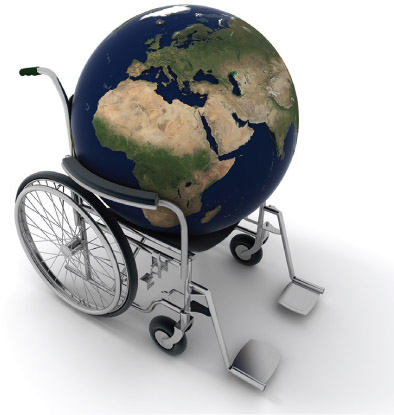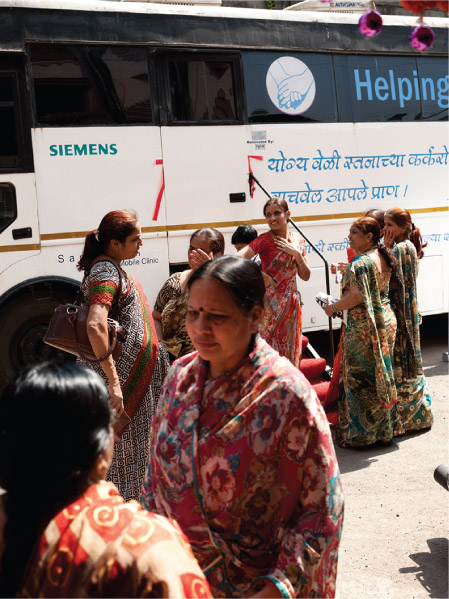8.5 ICT as development tools
The following are examples of how ICT can be used as development tools that use the concept of appropriate technology.
Leading innovation and technology for a sustainable future: Siemens Ltd Australia
Siemens is a German-based multinational organ-isation that has existed for 165 years and now operates in around 190 countries (go to www.cambridge.edu.au/hass9weblinks and follow the link to its website). The company aims to provide technology-based solutions

in the areas of energy, health care, industry and city infrastructure (such as transport).
Siemens commenced business in Australia during 1872 and with its affiliates, including Siemens New Zealand, has over 3200 employees. In order to work successfully across many countries, quick and efficient sharing of information using communications technologies has been crucial.
Siemens’ focus is on government and business customers. The company is proud of its long history and reputation as a reliable and trusted brand in the global market.
Business related to the environment and sustainability has been increasing over time, and in a recent Siemens financial year (1 October 2011 to 30 September 2012), the company earned €30 billion (approximately A$40 billion) from its environmental portfolio globally. Siemens is currently one of the world’s major suppliers of ‘ecofriendly’ technologies.
The four global megatrends
Siemens places great importance on research and design. It has used four global megatrends that reflect challenges facing our world and created business solutions to guide the company:
- Urbanisation. In 2009 more than 50% of people around the world lived in cities, and UN estimates suggest that this may increase to 70% by 2050. This places enormous pressures on existing resources and increases the need for more sustainable and energy-efficient design of urban buildings, transport and water supply.

Source 8.16 The United Nations estimates that 70% of the world’s population will live in cities by 2050. - Changing demographics. The world population is expected to increase from 7.06 billion (July 2012) to 9.2 billion in 2050. There will be a need for more preventive and early diagnostic technologies to cope with the dual trends of ageing and growing populations in various regions.

Source 8.17 The average age of the world’s population is expected to dramatically increase by 2050. - Globalisation. Technology is one factor that has helped the world become more interconnected; growing international trade and movement of workers are examples of the globalisation process.

Source 8.18 International trade has made the world more interconnected. - Climate change. There is a need for more efficient and renewable energy options to deal with the projected impacts of rising average global temperatures, and the world’s reliance on non-renewable fuels such as coal.

Source 8.19 The world will need to find renewable sources of energy to limit the effects of climate change.
Working to improve rural health care in India
Siemens currently employs over 17 000 people in India and has 23 major factories. Nearly 5000 employees are involved in research and development.
Siemens uses the concept of sustainability in terms of building the knowledge and skills of its workers. Empowering local people with leadership skills encourages an ongoing and collaborative work culture.

In 2001, Siemens developed the ‘mini-clinic on wheels’ with the aim of increasing access to and affordability of health services to rural areas in India. The Sanjeevan is a bus providing diagnostic equipment such as X-rays, ultrasound, a basic testing laboratory and some refrigerated medicines. These vehicles have been sold to local governments, private health providers and non-government organisations throughout India.
Experts at the Siemens Corporate Technology Centre in Bangalore are now investigating other high-quality but reasonably affordable options to improve the health of rural communities, such as CT (computed tomography) scans or MRI (magnetic resonance imaging) equipment.
DEVELOPING YOUR UNDERSTANDING 8.7
During the 2011–12 Siemens financial year, the company’s products and services enabled its customers to reduce carbon dioxide emissions by 332 megatons. This amount is equal to 40% of Germany’s total carbon dioxide emissions.
The One Laptop Per Child (OLPC) project
The general goal of the One Laptop Per Child project (OLPC) is for children in the least economically developed regions to gain empowerment using a laptop as a learning tool and as a means of connecting them with the wider world. The non-profit organisation based in the United States began providing laptops to children in 2007 (go to www.cambridge.edu.au/hass9weblinks and follow the link to their website). The green and white XO laptops are generally sold to governments and then allocated within the country by the Ministry of Education. The XO laptops use a wireless broadband connection. They can be used with electricity or other renewable energy options such as solar, wind, hydro or even ‘human power’.
According to the Project Coordinator Nkubito Bakuramutsa, the 2012 shipment cost about US$200 for each laptop: the aim was to allocate 200 000 by the end of the year to upper primary school children. Given that the laptops were designed for children, the processing speed is slower, but estimates suggest that they are about five times more energy efficient than conventional laptops. They are also robust, so they can cope with student use. The key advantage of the laptop is its mobility. Students can take them home and therefore involve the family in shared learning.
The philosophy of the project is that the computer should be regarded as a tool, like a pencil or paper. It is also important that students take ownership of – and care for – the technology.
Over 1500 teachers have been trained, which is another benefit in terms of the transfer of knowledge within these predominantly rural communities. The President of Rwanda introduced the project in 2008 to build the capacity of young learners and promote the country’s future development as a knowledge-based rather than a rural-based economy.
Source 8.20a This video looks at the One Laptop Per Child program in a village in Nigeria.(03:01)
DEVELOPING YOUR UNDERSTANDING 8.8
If India followed the World Health Organization’s recommendations of a 1:25 ratio of doctors to patients, India would require 4.8 million doctors.
DEVELOPING YOUR UNDERSTANDING 8.9
Copy the table below and evaluate the One Laptop Per Child project.
Develop a list of six criteria in order to make comparisons, and use the criteria to evaluate them.

| One Laptop Per Child | |
|---|---|
| Aim or goal of project | |
| Criterion 1: cost to produce | |
| Criterion 2: | |
| Criterion 3: | |
| Criterion 4: | |
| Criterion 5: | |
| Criterion 6: | |
| Preferred example of innovative and appropriate ICT - summary of findings |